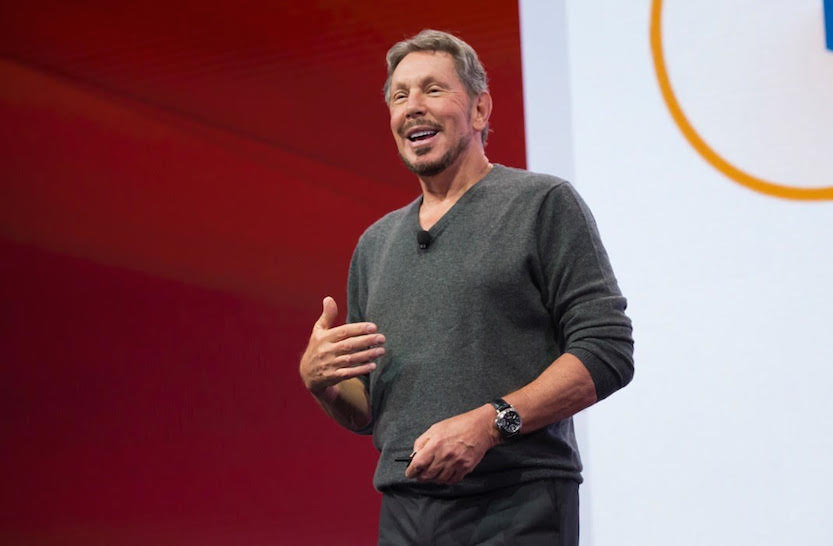 NEWS
NEWS
 NEWS
NEWS
 NEWS
NEWS
In his customary combative style, Oracle Chairman Larry Ellison today spent more than an hour slamming Amazon.com Inc.’s cloud computing as inferior on several fronts to the software giant’s own cloud.
Ellison (above), who had already thrown pointed barbs at Amazon Web Services Sunday evening in his first keynote at Oracle’s OpenWorld customer and partner conference in San Francisco, doubled down on his attack. He presented a series of benchmarks that purported to show how much faster and more capable the new second-generation Oracle cloud introduced Monday is than Amazon’s, which has been in operation for a decade.
For example, he said, Oracle’s cloud runs 24 times faster for analytics than Oracle on AWS. On transaction processing, he added, it’s eight times faster. Even one of Amazon’s own cloud databases, Redshift, is more than 100 times slower for analytics than Oracle’s. To hammer home the point, he showed a photo of an old flip phone (below right) to contend that Redshift is “a new name for an old product,” namely a “forked” version of the open source Postgres database. “AWS is slower, more expensive, less reliable,” Ellison said.
If nothing else, the presentation underscored how committed Oracle is to being a credible cloud force, whatever form it takes. “This is a very, very large-scale thing that is blessed all the way to Larry,” said Ashish Thusoo, chief executive of Qubole, a Big Data-as-a-service company that announced it’s integrated its service with the Oracle Cloud Platform.
Amazon couldn’t be reached for comment immediately after Ellison’s keynote, though it’s a safe bet that it will contest the comparisons. What’s more, the fact remains that Amazon Web Services is still far more popular than Oracle’s cloud in terms of revenues. AWS grossed $2.9 billion in the second quarter, compared with less than $1 billion for Oracle’s total cloud revenues.
The Oracle founder and chief technology officer also slammed Amazon for not making it easy or even possible to run Amazon databases anywhere but on AWS or to move workloads easily from AWS to other clouds. “AWS is more closed than an IBM mainframe,” he said. “Once you move into AWS, you cannot move out. If they raise prices, get out your checkbook. … You are locked in, baby.”
By contrast, Ellison painted Oracle as the more open of the two companies, since its database can run not only on Oracle’s cloud but also Amazon’s. Indeed, he went back decades to note that “we helped our customers migrate from minicomputers and mainframes to client-server. And we helped customers move from client-server to Internet computing.” Now, he said, “we’re making it easy to migrate and take advantage of the new kind of computing.”
The truth is that it’s difficult to move any sizable workload or data from a data center to the cloud or between clouds, both because of the enormous size of many databases and because of the complex nature of application setups for a particular company. What’s more, longtime Oracle customers accustomed to the company’s regular price hikes on software licenses over the years may find Ellison’s criticism of Amazon’s lock-in amusing.
“To Oracle’s credit they likely have a more performant, scaleable cloud database offering but they are still years off on the rest of the infrastructure stack features and offerings that make AWS such an attractive Swiss Army Knife for thousands of companies,” said Justin Moore, founder and chief executive of the cloud security and data protection company Axcient. “At the end of the day, Oracle will likely be a niche player for certain database and application workloads. It is extremely unlikely Oracle will reach the size and scale of AWS, Microsoft and a distant third Google.”
What Ellison clearly realizes, as Peter Burris, chief research officer at Wikibon (owned by the same company as SiliconANGLE), said this morning, is that Oracle needs to keep customers from straying to AWS and Microsoft Azure. And the way to do that, in the new world of open source, is to make customers comfortable with the potential to move their workloads where they want, while offering them technology that persuades them not to do so.
(* Disclosure: Oracle and other companies are sponsors of SiliconANGLE Media’s theCUBE at OpenWorld. Neither Oracle nor other sponsors have editorial control over content on theCUBE or SiliconANGLE.)
Support our mission to keep content open and free by engaging with theCUBE community. Join theCUBE’s Alumni Trust Network, where technology leaders connect, share intelligence and create opportunities.
Founded by tech visionaries John Furrier and Dave Vellante, SiliconANGLE Media has built a dynamic ecosystem of industry-leading digital media brands that reach 15+ million elite tech professionals. Our new proprietary theCUBE AI Video Cloud is breaking ground in audience interaction, leveraging theCUBEai.com neural network to help technology companies make data-driven decisions and stay at the forefront of industry conversations.